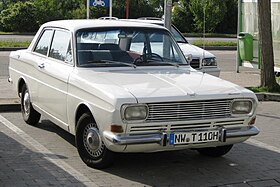Ford Taunus P6
| Ford Taunus 12M 1966-1967 Ford 12M 1967-1970 Ford Taunus 15M 1966-1967 Ford 15M 1967-1970 |
|
|---|---|
 |
|
| Overview | |
| Manufacturer | Ford Germany |
| Also called | Ford Taunus P6 |
| Production | 1966–1970 |
| Assembly |
Genk |
| Body and chassis | |
| Class | Small family car (C) |
| Body style | 2 or 4-door saloon 3-door “Turnier” estate car 2-door coupé |
| Powertrain | |
| Engine | 1183 cc V4 cylinder water-cooled (1967- 1968) 1305 cc V4 cylinder water-cooled 1498 cc V4 cylinder water-cooled 1699 cc V4 cylinder water-cooled |
| Transmission | 4-speed column mounted all-synchromesh manual central floor-mounted lever available from February 1968 |
| Dimensions | |
| Wheelbase | 2,527 mm (99.5 in) |
| Length | 4,389 mm (172.8 in) |
| Width | 1,603 mm (63.1 in) |
| Height | 1,385 mm (54.5 in)/1,400 mm (55.1 in)/1,425 mm (56.1 in) coupé/sedan/kombi |
| Curb weight | 845–925 kg (1,863–2,039 lb) |
| Chronology | |
| Predecessor | Ford Taunus 12M P4 |
| Successor | Ford Taunus TC |
The Ford Taunus 12 M is a range of small family saloons/sedans that were produced by Ford Germany between 1966 and 1970. There were two different engine sizes in the 12M. Two larger engines were available in the otherwise very similar Ford Taunus 15 M. From the outside the 15M was differentiated by its grill and rectangular headlights from the 12M which had round front lights. A complicating feature was the availability, at extra cost, of one of the larger engines from the 15M in the 12M.
It was first shown in September 1966. In August 1967 the model’s first and most significant facelift was marked by the removal of the “Taunus” name, and after this the cars were known simply as the Ford 12 M and the Ford 15 M.
The Taunus 12M name had been applied to the car’s predecessor and the 15M name had also been used until 1959 for an earlier model. This is why the 12M and 15M models introduced in 1966 are usually identified, in retrospect, as the Ford Taunus P6. It was the sixth newly designed German Ford to be launched after the war and for this reason it was from inception known within the company as Ford Project 6 (P6) or the Ford (Taunus) P6.
Between September 1966 and August 1970 when it was replaced 668,187 Ford (Taunus) P6s were produced. This was uncannily close to the 672,695 units of the predecessor model produced between 1962 and 1966. The Taunus P6 used different names for different engine sized cars, and it is recorded that approximately 385,000 of those produced were the (mostly smaller-engined) 12Ms while the larger-engined 15Ms accounted for approximately 285,000.
The Ford Taunus P6 inherited its wheelbase from the previous model but the new body was nevertheless longer and wider, though lower. This reflected the design trends evident throughout western Europe at the time. The car also inherited the V4 engine and front-wheel drive configuration which in 1960 had marked out its predecessor as an innovator. However, the P6 came with a choice of four different engine sizes whereas P4 buyers had been obliged to choose between just two.
The 12M and 15M shared the same body, but the front grill and headlamp treatments differed as did the rear light clusters. The rear light clusters on the 12M, reminiscent of those of the previous model, took the form of an extended lozenge. The rear light clusters on the 15M were rectangular.
As on the previous Taunus 12M, the engine was front-mounted and drove the front wheels. In France and Britain this layout was beginning to gain wider acceptance thanks to cars such as the Peugeot 204 and the Morris 1100, but in Germany, apart from pioneering models from the by now relatively low volume Auto Union brands that had introduced front wheel drive in the 1930s and applied it ever since, the Ford Taunus 12M/15M was still regarded as idiosyncratic in using this configuration.
...
Wikipedia
